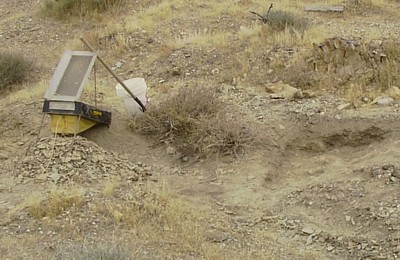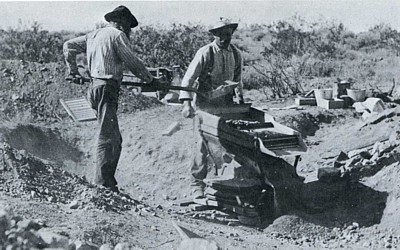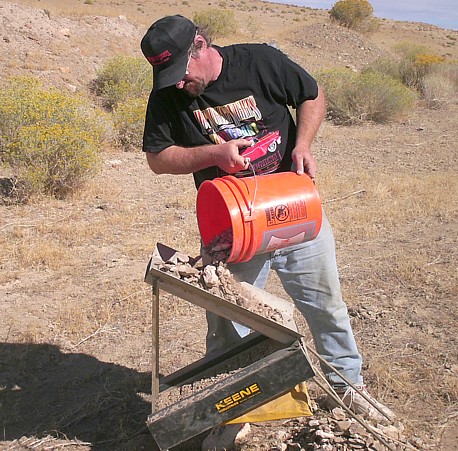Interested in operating a Dry Washer in the desert? This is my page of information on how to dig for gold with a Dry Washer......
Placer deposits have been mined in the desert regions of both the American southwest and Australia, as well as other places where very little water is available. Since conventional wet methods cannot be used to recover gold in these areas, various dry methods using air have been devised. In some areas, where there is a seasonal choice to process wet or dry it is far better to process gravel materials with water because a much higher percentage of the gold will be captured. Dry concentration techniques are much slower and inherently less efficient than wet concentration methods, and can only be used with small, dry particles that can be sorted by air streams of blowing air. Winnowing was the original dry placer method. This process involves screening out all the coarse gravel, placing the fines in a blanket and tossing them in the air, preferably in a good wind. The lighter particles are blown away by the wind and the heavier, usually more valuable minerals fall back onto the blanket. The weave of the blanket tends to hold fine gold. Winnowing is a very primitive method and is not used today. Basically, all it really does is remove the light clay dust particles from the mix. | ||
| . | ||
Dry panning is a similar winnowing process, and is only slightly better than blanket winnowing. Shaking the pan while gently winnowing allows the gold to settle in an action similar to a jig. A far better and more successful method is dry washing, also called dry blowing in Australia. The dry washer allows for the processing of gravels at a much higher rate than possible by winnowing or dry panning. In fact, the most widely used piece of dry recovery equipment is the dry washer. For all intents, the dry washer is basically designed to be a short, waterless sluice. It separates gold from sand by pulsations of air coming up through a porous cloth medium. The vibrations and flow of air replace the function of water in the normal sluice, allowing the gold to settle downward. Screened gravel passes down an inclined riffle box with cross riffles. The bottom of the box consists of a thin, light weave canvas or some other fabric. Beneath the riffle box is a bellows, which blows air in short, strong puffs through the canvas. This gives a combined shaking and classifying action to the material. There is also a bellows type which has a battery powered electric motor that operates the bellows for the operator. Other designs employ a motorized blower to provide a continuous flow of air. Dry washing, by its very nature, is an extremely dusty process and the operator is urged to stay up wind as much as possible and even to consider wearing a dust mask when dust cannot be avoided. |  | |
With both types, the gold gravitates down to the canvas and is held by the riffles, which are set up in the direction opposite of a normal wet sluice. The waste passes over the top of the riffles and out of the end of the sluice section. A basic dry washer is composed of a frame in which a well braced, heavy support screen is covered with fine linen. Above this, riffles made of one-half to three-quarter-inch, L shaped steel or a quarter-round wood molding placed 4 to 6 inches apart. The slope of the box varies from 3 to 6 inches per foot. A power washer of this type can process up to 21 cubic feet (approximately 0.8 cubic yards) of loose material an hour. Hand-powered washers operated by two men can process 1 or more cubic yards per 8 hours, depending on the size of the material handled. For recovery of gold, the gravels to be processed must be completely dry and well disintegrated. It is critical that the gravels are fully dry because in even slightly damp materials, the clay will clump with the gold preventing good recovery. As a result, any gravel must be thoroughly dry before treatment. During dry times of the year the gravels may be naturally without water, but after stormy periods drying may be required. For small-scale work, sun drying will dry material will usually do the trick. In addition, materials with a heavy clay content, or those bonded together with the caliche will clump up even when dry, so breaking up of the clumps by hand or other methods may be necessary for good recovery. Fully dry, sandy material gives the best recovery results in dry washing. During operation, dry gravels is fed onto the scalping screen of the dry washer where the finer material falls through the screen into the sluice section and is processed over riffles. The oversize goes off the screen, and the processed gravels fall off the edge at the end of the sluice section. The bellows or blower is operated by hand cranking or powered by a small motor. The bellows should be operated at about 20 pulsations per minute with a stroke of about 3 inches. These figures will vary with the coarseness of processed material and the fineness of the gold. Operation continues until about one or two cubic yard of material has been processed. | ||
During operation, dry gravels is fed onto the scalping screen of the dry washer where the finer material falls through the screen into the sluice section and is processed over riffles. The oversize goes off the screen, and the processed gravels fall off the edge at the end of the sluice section. The bellows or blower is operated by hand cranking or powered by a small motor. The bellows should be operated at about 20 pulsations per minute with a stroke of about 3 inches. These figures will vary with the coarseness of processed material and the fineness of the gold. Operation continues until about one or two cubic yards of material has been processed. Operating a dry washer is not terribly difficult. This webpage gives the basic information and instructions necessary to learn How to operate a dry washer. The tilt of the scalping screen is not that critical, but should be steep enough to allow loose rock oversize to run off, without being so steep that the dirt and undersize material you are seeking to process runs off the screen as well. The tilt of sluice box section of the dry washer is more critical. Like a wet sluice box it should be set at an angle steep enough to allow most of the material to flow through the sluice box section within a reasonable period of time. This would be something like 20 seconds for material to work its way down from the top of the sluice down to the bottom and out on the tailings pile. |  | |
Many dry washers have an adjustable feed port control. There should be adjusted to prevent overloading of the sluice box section. Too much material, coming in too fast will bury the riffles and result in poor recovery. Most of the motorized blower types are really a two man operation, or at least one man working very hard. They process a lot of gravels and a single operator will be working hard to keep the unit properly fed with material. Another important fact about blower type dry washer operations is to make sure that a reasonable amount of material is coming in at all times. Allowing the air to blow for a long period of time with no new material coming in will tend to scour the riffles and lead to loss of gold. | ||
| Because all dry placer methods are inefficient, it is normal that a certain percentage of the very fine gold is lost. As a result of this, it is common to reprocess the dry washer tailings and recover additional gold. This is especially true if you hit a good paystreak and are recovering significant amounts of gold - you will want to rerun your tailings, because it will almost always be well worth the effort. Unlike the water powered wet sluice box, where you may go a full day between cleanups, regular cleanup of the dry washer sluice box is a must to prevent excessive loss of gold. Perhaps two hours is the very most you would want to run between cleanups, much better would be one hour. During cleanup, the riffle box is lifted out and turned over into a large container. The concentrates from the riffles are panned as with any placer concentrates, and the gold removed. Usually the coarse and some fine gold are most abundant in the upper riffle section. The lower riffles may contain a few colors, but nearly all the recovered gold is caught in the upper riffles. The concentrates from the dry washer may be further refined by panning or other means. If water is very scarce, the concentrates may saved and processed elsewhere. Dry washers are portable, comparatively inexpensive, and easy to use. The dry washer is merely a tool for finding gold. You are the one who has to find a spot that has the productive gold bearing gravel. As with other prospecting tools, the dry washer is not that difficult to learn to operate, the difficulty is in finding paying deposits of gold bearing gravels. As with dredging and sluicing, the key to finding paying deposits of gold is an intelligent sampling program. Be sure to check a number of areas that look good and see what amounts of gold they yield. |  | |
Comments: 0
Post a Comment